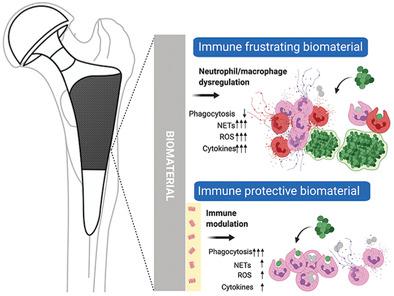当前位置:
X-MOL 学术
›
Adv. Mater.
›
论文详情
Our official English website, www.x-mol.net, welcomes your
feedback! (Note: you will need to create a separate account there.)
Combating Implant Infections: Shifting Focus from Bacteria to Host.
Advanced Materials ( IF 27.4 ) Pub Date : 2020-09-11 , DOI: 10.1002/adma.202002962 Saber Amin Yavari 1 , Suzanne M Castenmiller 2 , Jos A G van Strijp 2 , Michiel Croes 1
Advanced Materials ( IF 27.4 ) Pub Date : 2020-09-11 , DOI: 10.1002/adma.202002962 Saber Amin Yavari 1 , Suzanne M Castenmiller 2 , Jos A G van Strijp 2 , Michiel Croes 1
Affiliation

|
The widespread use of biomaterials to support or replace body parts is increasingly threatened by the risk of implant‐associated infections. In the quest for finding novel anti‐infective biomaterials, there generally has been a one‐sided focus on biomaterials with direct antibacterial properties, which leads to excessive use of antibacterial agents, compromised host responses, and unpredictable effectiveness in vivo. This review sheds light on how host immunomodulation, rather than only targeting bacteria, can endow biomaterials with improved anti‐infective properties. How antibacterial surface treatments are at risk to be undermined by biomaterial features that dysregulate the protection normally provided by critical immune cell subsets, namely, neutrophils and macrophages, is discussed. Accordingly, how the precise modification of biomaterial surface biophysical cues, or the incorporation of immunomodulatory drug delivery systems, can render biomaterials with the necessary immune‐compatible and immune‐protective properties to potentiate the host defense mechanisms is reviewed. Within this context, the protective role of host defense peptides, metallic particles, quorum sensing inhibitors, and therapeutic adjuvants is discussed. The highlighted immunomodulatory strategies may lay a foundation to develop anti‐infective biomaterials, while mitigating the increasing threat of antibacterial drug resistance.
中文翻译:

对抗植入物感染:将重点从细菌转移到宿主。
植入物相关感染的风险正日益威胁着生物材料广泛用于支撑或替换人体部位。为了寻找新颖的抗感染生物材料,通常将侧重点放在具有直接抗菌特性的生物材料上,这会导致抗菌剂的过度使用,宿主反应减弱以及体内不可预测的有效性。这篇综述揭示了宿主免疫调节,而不是仅针对细菌,如何赋予生物材料更好的抗感染特性。讨论了如何通过生物材料功能破坏抗菌表面处理的风险,这些功能会异常调节正常情况下由关键免疫细胞亚群(即嗜中性粒细胞和巨噬细胞)提供的保护。因此,综述了生物材料表面生物物理线索的精确修饰或免疫调节药物传递系统的结合如何使生物材料具有必要的免疫相容性和免疫保护性,以增强宿主防御机制。在此背景下,讨论了宿主防御肽,金属颗粒,群体感应抑制剂和治疗性佐剂的保护作用。突出的免疫调节策略可能为开发抗感染生物材料奠定基础,同时减轻抗菌药物耐药性日益增加的威胁。在此背景下,讨论了宿主防御肽,金属颗粒,群体感应抑制剂和治疗性佐剂的保护作用。突出的免疫调节策略可能为开发抗感染生物材料奠定基础,同时减轻抗菌药物耐药性日益增加的威胁。在此背景下,讨论了宿主防御肽,金属颗粒,群体感应抑制剂和治疗性佐剂的保护作用。突出的免疫调节策略可能为开发抗感染生物材料打下基础,同时减轻抗菌药物耐药性日益增加的威胁。
更新日期:2020-10-26
中文翻译:

对抗植入物感染:将重点从细菌转移到宿主。
植入物相关感染的风险正日益威胁着生物材料广泛用于支撑或替换人体部位。为了寻找新颖的抗感染生物材料,通常将侧重点放在具有直接抗菌特性的生物材料上,这会导致抗菌剂的过度使用,宿主反应减弱以及体内不可预测的有效性。这篇综述揭示了宿主免疫调节,而不是仅针对细菌,如何赋予生物材料更好的抗感染特性。讨论了如何通过生物材料功能破坏抗菌表面处理的风险,这些功能会异常调节正常情况下由关键免疫细胞亚群(即嗜中性粒细胞和巨噬细胞)提供的保护。因此,综述了生物材料表面生物物理线索的精确修饰或免疫调节药物传递系统的结合如何使生物材料具有必要的免疫相容性和免疫保护性,以增强宿主防御机制。在此背景下,讨论了宿主防御肽,金属颗粒,群体感应抑制剂和治疗性佐剂的保护作用。突出的免疫调节策略可能为开发抗感染生物材料奠定基础,同时减轻抗菌药物耐药性日益增加的威胁。在此背景下,讨论了宿主防御肽,金属颗粒,群体感应抑制剂和治疗性佐剂的保护作用。突出的免疫调节策略可能为开发抗感染生物材料奠定基础,同时减轻抗菌药物耐药性日益增加的威胁。在此背景下,讨论了宿主防御肽,金属颗粒,群体感应抑制剂和治疗性佐剂的保护作用。突出的免疫调节策略可能为开发抗感染生物材料打下基础,同时减轻抗菌药物耐药性日益增加的威胁。

















































 京公网安备 11010802027423号
京公网安备 11010802027423号